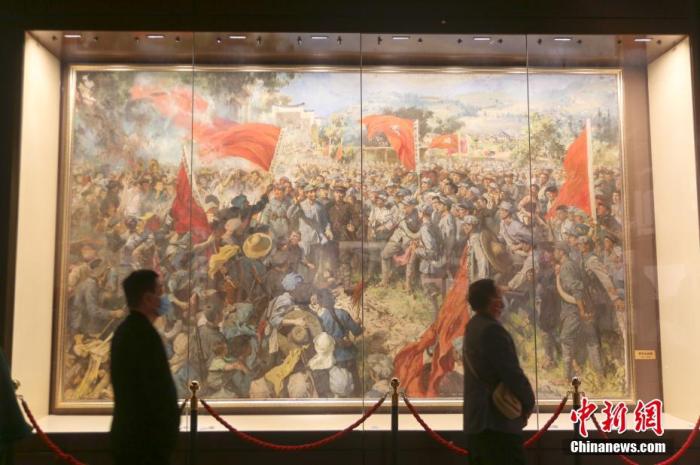China News Service, May 25th. On the 25th, Guan Qiang, deputy director of the State Administration of Cultural Heritage, introduced at the press conference that in 2020, museums across the country will hold more than 29,000 exhibitions, plan more than 225,000 educational activities, and adopt current restrictions in the normalization of the epidemic. Under the measures, 540 million audiences were still received, including 130 million minor audiences. "Going to the museum" has become a new social trend.
Data map: Visitors watch the oil painting "Jinggangshan Meeting Master" in the Jinggangshan Revolution Museum.
Photo by China News Agency reporter Liu Lixin
On May 25th, the State Council Information Office held a press conference on the guidelines for the reform and development of museums.
At the meeting, Guan Qiang pointed out that since the 18th National Congress of the Communist Party of China, my country's museum industry has made historic achievements.
One is the gradual optimization of the layout of the museum system.
During the 13th Five-Year Plan period, the number of registered museums nationwide increased from 4,692 to 5,788, an increase of 23.4%.
Among them, there are 1,224 national first-, second-, and third-level museums, 1,860 non-state museums, and 5,214 free museums. A modern museum system with rich types and diverse subjects has basically taken shape.
The second is the effective play of the museum's social functions.
In 2020, museums across the country will hold more than 29,000 exhibitions and plan more than 225,000 educational activities. In the case of the normalization of the epidemic and current limiting measures, they will still receive 540 million visitors, including 130 million minors. "Go to the museum "Go" has become a new trend in society.
Third, the management level of museums has been significantly improved.
The museum's legal system has been continuously improved, and the State Administration of Cultural Heritage and the education, civil affairs, and finance departments have successively issued a series of guiding documents.
The museum quality evaluation system is gradually established, and the construction of the board of directors system is progressing in an orderly manner.
The "double random and one open" inspection in the museum field has become an effective means to promote increasingly standardized and standardized museum management.
Guan Qiang said that in the face of the new era, new situation, and new demands, the contradiction between the unbalanced and inadequate development of museums and the people’s ever-increasing needs for a better life is still prominent. How to respond to the needs of the times and further stimulate the vitality of the museum’s development? The fundamental transformation of museums from quantity growth to quality improvement is an urgent problem to be solved in the development of museums.
To this end, the State Administration of Cultural Heritage, together with relevant departments, has studied and drafted the "Guiding Opinions on Promoting the Reform and Development of Museums" for nearly three years, which was reviewed and approved at the 9th meeting of the Central Leading Group for Cultural System Reform and Development. The Ministry of Publicity, the Development and Reform Commission, the Ministry of Education, the Ministry of Science and Technology, the Ministry of Civil Affairs, the Ministry of Finance, the Ministry of Human Resources and Social Security, the Ministry of Culture and Tourism, and the National Cultural Heritage Administration jointly issued it.
The "Opinions" proposed that by 2025, a development pattern of museums with reasonable layout, optimized structure, distinctive features, complete systems, and complete functions will be formed, and the quality of museum development will be significantly improved, and it will promote the excellent traditional Chinese culture, revolutionary culture and advanced socialist culture. , The role of building a public cultural service system, serving the people's better life, promoting economic and social development, and promoting exchanges and mutual learning between human civilizations is more prominent.
By 2035, the museum system with Chinese characteristics will be more mature and finalized, and the social functions of museums will be more complete. It will basically become a world museum power and contribute Chinese wisdom and Chinese solutions to the development of global museums.
Guan Qiang also pointed out that as a programmatic document for the comprehensive deepening of the reform of the museum industry in the new era, the "Opinions" cover all aspects of the development of the museum industry, divided into 5 parts and 21 specific measures, and put forward the guiding ideology including the museum reform and development , Basic principles and development goals.
In addition, Guan Qiang also mentioned that the highlights and innovations of the "Opinions" lie in three aspects: persistence in reform and innovation, persistence in overall planning and coordination, and persistence in openness and sharing.
Persist in reform and innovation.
Adhere to problem-oriented, goal-oriented, upper and lower linkages, and horizontal alliances, encourage the first to try, break the constraints of systems and mechanisms, and release the vitality of development.
Such as exploring the establishment of joint certification of industry museums and joint management mechanisms.
Insist on overall coordination.
Coordinate the development of museums in different regions, levels, attributes, and types, and improve the internal management and external governance of museums.
Improve the level of equalization, convenience, diversification, and individualization of museum public services to achieve high-quality and differentiated development of museums.
For example, implement the plan to create a world-class museum with Chinese characteristics, focusing on cultivating 10-15 world-class museums that represent the Chinese style with Chinese characteristics and lead the development of the industry.
Insist on open sharing.
Create an open and inclusive development environment, promote the orderly flow of resource elements, optimize the allocation of resources, and use multiple measures to activate museum collections through regional collaborative innovation, social participation, cross-border cooperation, and Internet communication.
Such as the implementation of the "museum +" strategy to promote cross-border integration between museums and education, technology, tourism, commerce, media, and design.

